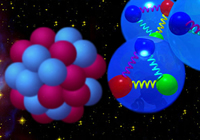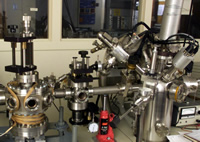
The Astronomy and Astrophysics Group at Texas A&M-Commerce is concerned primarily with observational and theoretical studies of asteroids, white dwarf stars, and cataclysmic variable binary systems. We are a member of the Southeastern Association for Research in Astronomy (SARA), and have a 10% share of three 1-m-class telescopes located at premier astronomical observatories in Arizona, USA, in Chile, South America, and on the island of La Palma in the Canary Islands off the coast of Morocco. We also operate the 0.6-m TAMUC Observatory located 5 miles south of Campus. Faculty: Kent Montgomery, Kurtis Williams, Matt A. Wood.
 We are theorists modeling and calculating observables in direct reactions, heavy ion central collisions, fusion reactions, formation and decay of compound nuclei, nuclear structure, mean field theories, radiative capture reactions, transport theories, neutrino scattering, white dwarfs, neutron stars, supernovae and applications of computer science. Our research encompasses many branches of nuclear science such as stellar evolution, stockpile stewardship, and national security.
We are theorists modeling and calculating observables in direct reactions, heavy ion central collisions, fusion reactions, formation and decay of compound nuclei, nuclear structure, mean field theories, radiative capture reactions, transport theories, neutrino scattering, white dwarfs, neutron stars, supernovae and applications of computer science. Our research encompasses many branches of nuclear science such as stellar evolution, stockpile stewardship, and national security.
We are managing the DOE funding for the CUSTIPEN: China-U.S. Theory Institute for Physics with Exotic Nuclei. This institute, jointly funded by DOE Office of Sciences and several Chinese Institutions, provide funds for U.S. researchers to visit collaborators in China, and for Chinese researchers to visit U.S. universities and national laboratories.
Faculty: Carlos Bertulani, Bao-An Li, William Newton.
 Surface Physics is the study of the structure and properties of the atoms on the surface of materials. The Surface Physic Laboratory at Texas A&M University-Commerce offers a wide variety of experimental research opportunities including X-Ray Photoelectron Spectroscopy (XPS) and Soft X-Ray and Auger Electron Appearance Potential Spectroscopy (APS). Faculty: Anil Chourasia.
Surface Physics is the study of the structure and properties of the atoms on the surface of materials. The Surface Physic Laboratory at Texas A&M University-Commerce offers a wide variety of experimental research opportunities including X-Ray Photoelectron Spectroscopy (XPS) and Soft X-Ray and Auger Electron Appearance Potential Spectroscopy (APS). Faculty: Anil Chourasia.
Organic semiconductors are vigorously studied for their potential in next generation opto-electronic devices. They have many advantages over inorganic materials such as silicon, which is the most commonly used inorganic semiconductor for electronic devices. Most organic semiconductors are less expensive, flexible and versatile. However their material properties are still not well understood compared to inorganic materials. My research focuses on exciton and charge carrier dynamics in organic materials and organic/inorganic hybrid systems. This work is critically important because there are still several issues in using organic materials in optoelectronic devices such as organic solar cells and organic light emitting diodes (OLED). For example, control of excitons (bound electron-hole pairs) at the hybrid interface is not efficient primarily due to highly localized states on the surface of inorganic substrates. Resolving the interfacial states problem and elucidating the characteristics of excitons and charge carriers represent critical steps to achieve efficient organic-based devices. Faculty: Dr. Heungman Park (webpage).
Physics Education Research is focused on understanding how to improve the teaching and learning of physics. In our work at A&M-Commerce, we seek to identify and understand teaching strategies that build physics identity. Our methods include analyzing both national survey data and case studies. We study the factors that affect students' career decisions with the goal of increasing the number of physics majors from underrepresented groups, including women, and also to improve the attitudes of all students regarding physics. Faculty: Robynne Lock and Bahar Modir.
To request a change to this page or to request access to make changes yourself, email helpdesk@tamuc.edu.

